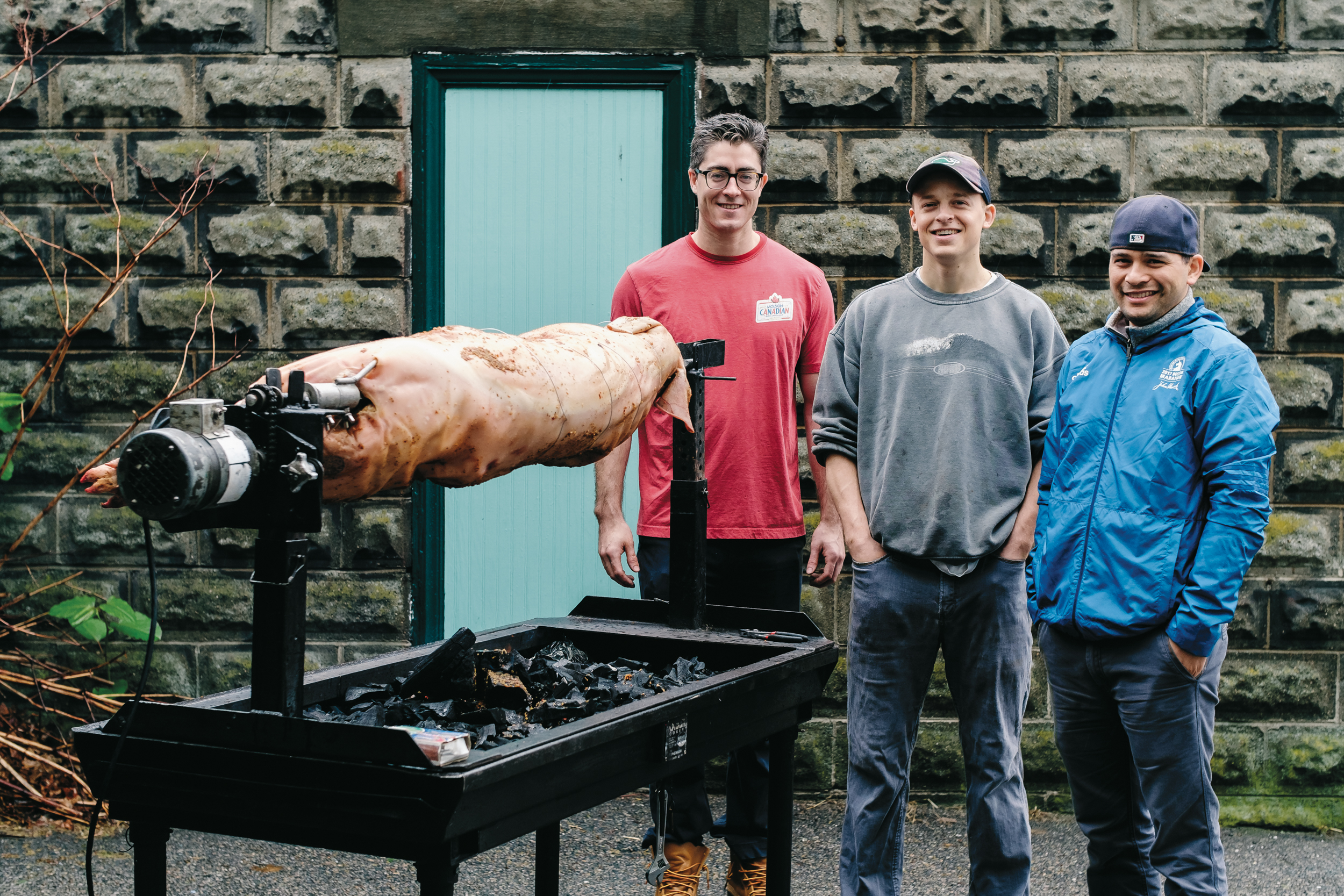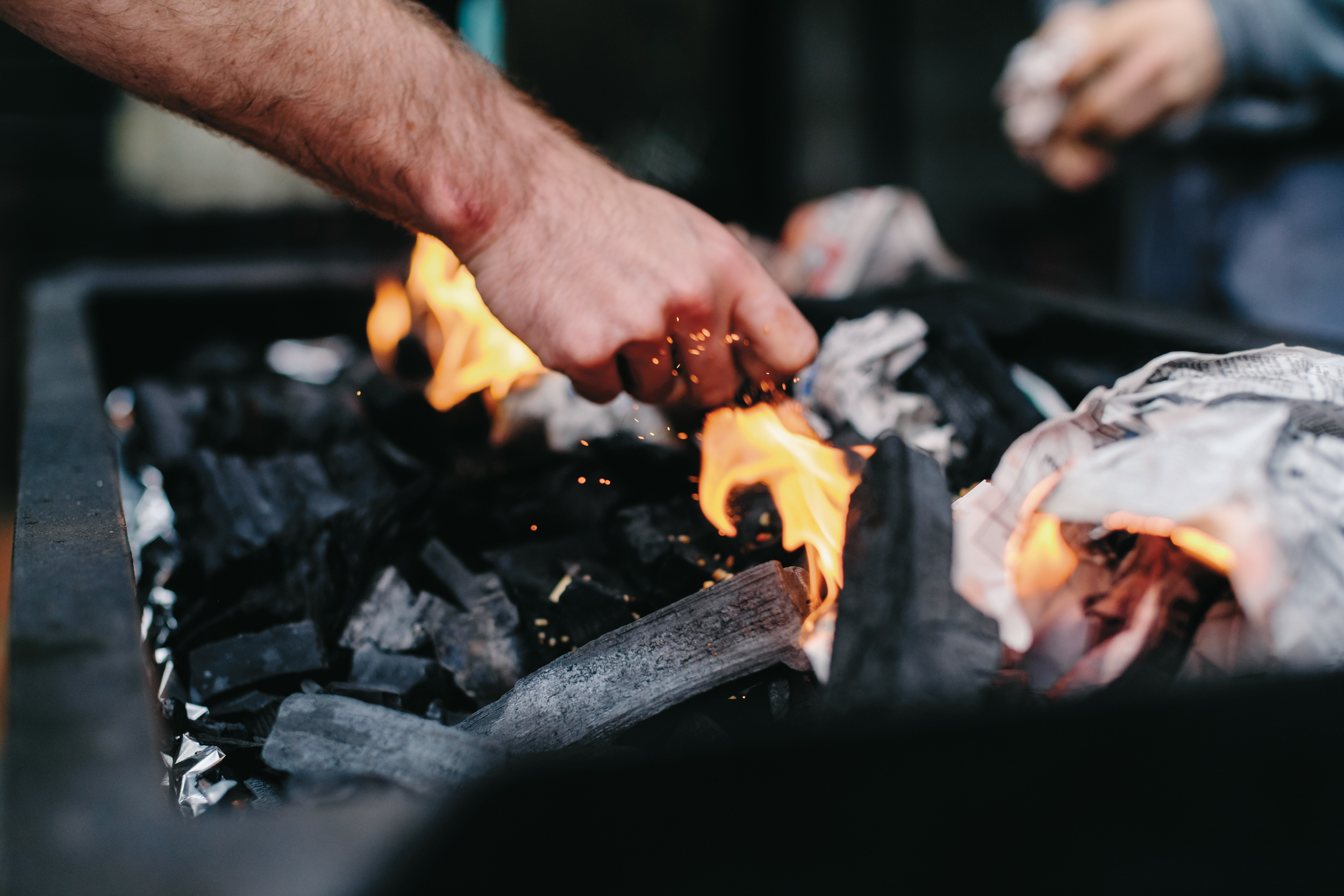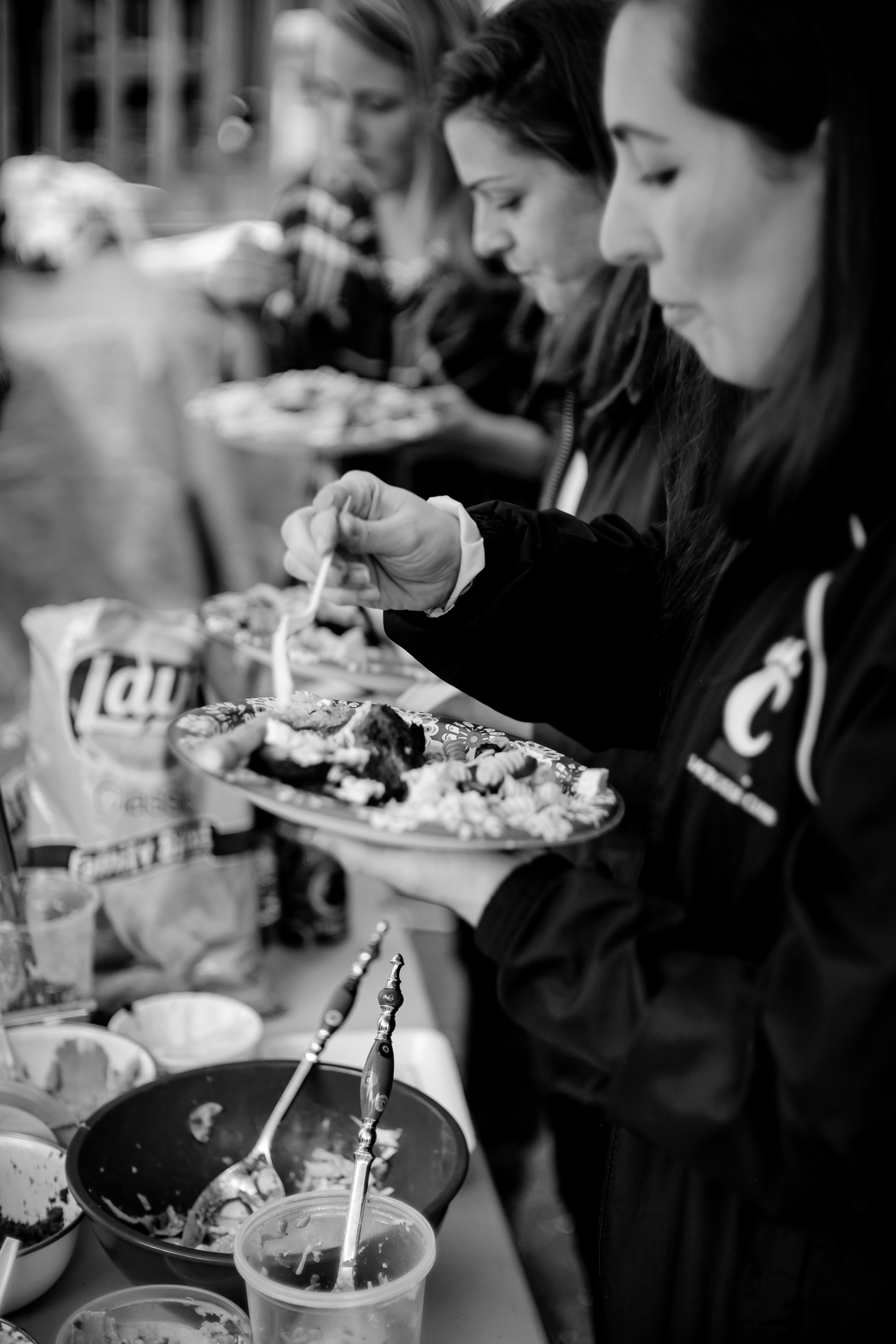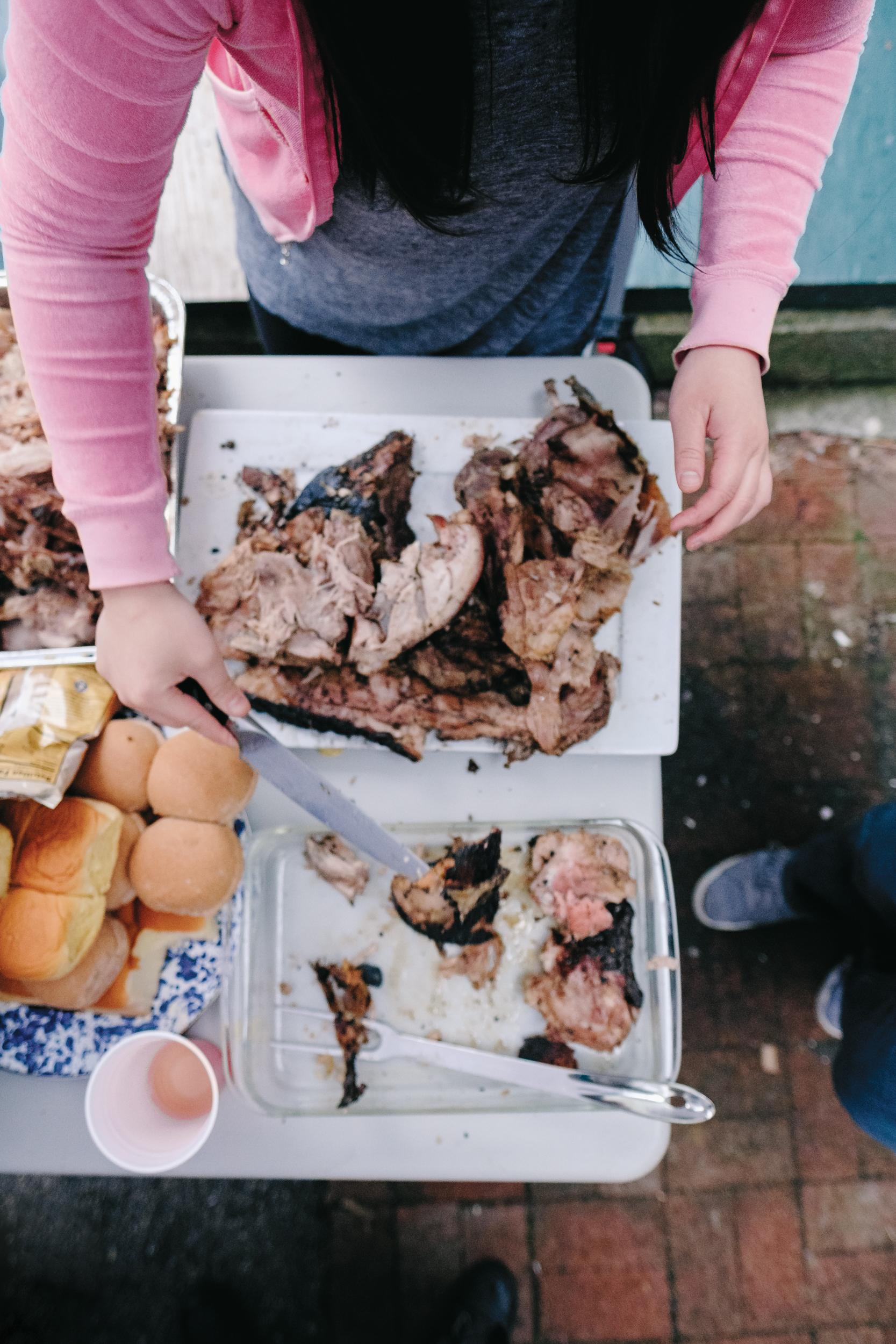A Roast To Remember
Photos by Joseph Ferraro
As I turn into a concrete driveway on a side street in Brookline, I’m met by an impressive sight: a whole pig tied to a rotisserie grill turning slowly over a bed of hot coals. Three men tend to it attentively, dressed in sweatshirts with long sleeves to protect them from the heat and smoke.
Nearby, a jovial crowd hovers around a table of snacks and beer under a pop-up tent, erected in anticipation of that evening’s rain which, thankfully, never comes. Several people spill over from a back porch into the small yard, sipping drinks, chatting cheerfully. Still others huddle around the kitchen table inside. Relaxed, upbeat tunes waft from a makeshift sound system in the open garage.
My host, Harper Gay—tall, lean, in his 30s—takes a break from the pig to flash me a warm smile that puts me instantly at ease. He welcomes me to this year’s pig roast and pours me a glass of wine. Helping him with the pig are Kevin Izzo, his childhood neighbor who’s pursuing his MBA at Boston College; and Joe Quinto, whose fiancée worked with Harper’s. Both currently live close enough to come over at 7am to prep the grill and the pig, and get the beast on the spit. Given its size, it’s really a two- to three-person job, and is the real hard work before the grilling begins.
Harper’s inspiration to start his annual event came from his parents. When they previously lived in Virginia, they’d host an annual croquet gathering that guests looked forward to every year. Harper started the pig roast with a few close friends from his Vermont hometown, and it quickly grew to include different groups of friends and neighbors—who all now look forward to the yearly event. An annual gathering like this is a great way to stay in touch with old friends, get to know new ones and encourage a sort of social cross-pollination.
Why a pig roast? “I enjoy the spectacle of the pig. Also, it’s not something I’d ever do by myself,” he quips. As an undergraduate at Dartmouth College, he’d attended a few pig roasts as part of their annual Spring Fling. Now a graduate student at the Fletcher School of Law and Diplomacy at Tufts, he wanted to bring together many of the international students he met there.
“Many cultures roast lamb and goat,” he explains, “but I felt pig was particularly American.” Since his is a potluck event, he also enjoys seeing what others bring. “Once, someone brought 12 boxes of Kraft Mac & Cheese,” he laughs.
This year’s motley spread is more “get ’er done” than gourmet: two pasta salads, veggie sticks with hummus, roast potatoes, olive dips and taralli—Italian wine crackers—made by Seven Hills Farmstead, a local food business run by Harper’s friend Giulio Caperchi and his wife, Carol. S’mores cookies and two kinds of brownies make up the dessert section.
“We also make sure there’s stuff like veggie burgers, Brussels sprouts or corn," Harper says—Halimah, his fiancée, is vegetarian. My contribution is a Thai-style coleslaw, which went over well enough for me to make a few new friends. Food is a wonderful connector.
The pig, of course, is the centerpiece. “I don’t insist that everyone else bring locally sourced food, but it’s an important value to me so I proudly source local pigs.” The first year’s pasture-raised pig was from Savenor’s; subsequent suppliers include Lilac Hedge Farm (Holden, MA) and Kalon Farm (Lancaster, MA)—the latter Harper had heard about through Edible Boston.
“A lot of people don’t realize how close to Boston these farms are.” The pig is brought home in a cooler, where it’s kept for the dry rub and marinade. Though he experiments with various marinades, they always include apple cider vinegar and Vermont maple syrup.
Giulio is in charge of carving the pig. He moves with practiced ease between grill and beast in silence, intensely focused on the task at hand. From a distance, he looks not unlike the stereotypical image of a frat boy: a peaked baseball cap worn backwards and lazy blue jeans. The illusion shatters the minute he opens his mouth: I suddenly feel as though I’m talking to Al Pacino in The Godfather. He has a heavy Italian accent and talks with his hands. But he doesn’t talk much: There were some unexpected flare-ups during the roast, and the parts of the pig that got badly charred need to be carefully trimmed away.
This isn’t the first time the roast hasn’t quite gone according to plan. When he started his pig roast four years ago, Harper didn’t quite know how to have the pig dressed to hook up to the grill correctly. He’d had it butterflied, and partway through the cooking it split right down the middle. He recalls an incident from another year:
“When you buy a pig, the farmer gives you a weight range estimate so you can buy enough charcoal to cook it. The animals usually average between 60–70 pounds. One year, the pig ended up weighing so much more than we expected that we ran out of charcoal—right when the large crowd was getting hungry for dinner.” Since there wasn’t time to run out and get more charcoal, a friend of his had a suggestion: that they wrap the entire grill (six feet long, five feet high) in foil. “This is a terrible idea,” Harper said. “It’s never going to work.” Desperate for a solution, they tried it anyway. Within 45 minutes, the pig was cooked perfectly. “So we decided to do it again this year.”
Rather than be daunted by mishaps, he maintains a positive attitude and open mind, and the pig now tastes good and is finished on time.
This group’s focus is less on fine dining and more on socializing. A birthday boy is blindfolded and made to beat a donkey-shaped piñata. We squeal with anticipation at every blow; the stick ends up splitting before the piñata does but he bravely carries on. There is a final crack, and the group roars and dives to its knees as a spatter of candy and boozy nips hits the concrete driveway. As I watch people, I realize I’m smiling: It’s been years since I let myself get swept away into a feeling of carefreeness, of being here and now.
Growing up in a food-centric family, our dinner parties tended to involve intricate menu planning, overthinking, micromanagement and, typically, undue amounts of stress. In time, the number of gatherings dwindled. This evening I learned a different approach: Share the love between the food and the collective social experience. Rather than providing all the food down to the last detail, focus on one big-ticket dish. Allow your guests to participate by bringing side dishes and beverages, or helping with tasks at the event—it helps them feel more involved, and takes some of the pressure off you. You’ll have a better time, and guests will look forward to your gatherings.
Thoughtfully inviting different groups of people allows new memories to be made and new friendships to be formed. Because—let’s face it—as much as we love it, food is just the gateway to the thing we crave even more: human connection.
This story appeared in the Fall 2017 issue.







